Life might be better if we started each day with a freshly baked cinnamon roll. First the heavenly smell of homemade bread in the oven, mixed with the spice of cinnamon. Then the anticipation of seeing the hot tray of tightly packed, toasty golden rolls, oozing a butter and brown sugar caramel. Finally a steamy swirled roll on a plate and a warm, soft, soul-warming bite of sweet dough and spicy sugar. Every day might be too much to ask, but these simple cinnamon rolls are certainly a perfect way to start off a sweet new year.
For over thirty years my in-laws had a wonderful neighbor, Angie, whose Christmas gift every year was homemade cinnamon rolls. Small, sticky and dripping with buttery glaze, they were a juicy little mouthful to complement our savory Christmas morning strata. Since Angie passed away two years ago, I make cinnamon rolls for Christmas and think of her, with her soft white bob and bright blue eyes, looking for all the world like Mrs Claus.
I have Angie’s butterscotch roll recipe, but with four little ones I don’t have days to spend making cinnamon rolls the way Angie did. I use a simpler recipe from allrecipes.com, which produces a dozen soft, oozy, homemade cinnamon rolls with less than an hour of active work. I almost always make these the night before, refrigerate them overnight and then bake in the morning. But you don’t have to wait.
This is a very dependable recipe, and as usual I was happy with the (quadruple!) batch I made for Christmas. Still I couldn’t help tinkering when I thought about posting the recipe. I hauled out my ingredients again and made another single batch to test three minor modifications: 1) substituting some whole wheat flour for all purpose flour in the dough, 2) using less sugar in the filling and 2) adding a bit of flour to the filling to keep it from melting out of the rolls.
The results:
- One cup of whole wheat flour worked just fine, a bit more texture but not dense. I would do this again.
- Less sugar (3/4 cup instead of 1 cup) still made for sticky-sweet cinnamon rolls without the slight granular crunchiness of the full sugar version. And my kids ate the reduced-sugar version as enthusiastically as they had the full-sugar rolls.
- A tablespoon of flour does keep the filling in the roll. But the end result is more like a cinnamon Danish pastry. My panel of enthusiasts preferred the buttery sugary filling oozing out.
- I worked in a bit too much flour in the test batch, and the rolls were not as tender as my Christmas morning batch. Next time I would stop adding flour while the dough was still ever-so-slightly sticky.
I’m going to use my test batch pictures to illustrate here, because I don’t want to scare anyone off this wonderfully easy recipe with intimidating pictures of my quadruple batch. My stiff dough wasn’t great for the taste, but at least it made for picture-tidy rolls.
Scald milk (this deactivates a protein that can interfere with bread rising) by bringing just to boil on stovetop. Watch carefully, as it’s easy to go from scald to scorch. Remove from heat and add butter to melt. Leave to cool.
The original recipe from allrecipes doesn’t call for proofing the yeast. But enough of the allrecipes reviewers had problems with dough rising properly that I’m recommending you proof the yeast first. It’s a simple matter: add yeast granules to warm water (a finger dipped in the water should feel pleasantly warm). Carefully stir yeast and let sit while assembling dry ingredients. Yeast will look foamy when activated.
In a large mixing bowl, add flour, sugar and salt. Mix well.
Add egg to milk mixture and beat well.
Check on yeast. If it does not look foamy, add a teaspoon of sugar and stir gently. This should really get the yeast rising, like this.
Add milk mixture and activated yeast/water mixture into dry ingredients.
Stir until dough holds together in a sticky ball.
Now it’s time to get your hands dirty. Add additional flour, 1/4 cup at a time, and knead until dough is soft and smooth but still springy and a tiny bit sticky. Don’t be afraid to get in there and push that dough around. It’s therapeutic.
Cover dough with damp cloth and let rest for 10 minutes while you mix the filling. If you are letting the dough rest in the bowl, a large domed pot lid over the dough will also work as long as the dough has room to rise underneath.
Softened butter, brown sugar and cinnamon (ignore the flour in the picture, unless you want a cinnamon Danish).
Roll dough into a rectangle, approximately 14″x12″. The original recipe calls for a 12″x9″ rectangle, but I like to roll it thinner so that the cinnamon roll has more layers.
Spread filling evenly over dough. Make sure the filling gets to the side edges so that the end rolls aren’t dry. Leave an inch or so at the top edge without filling so that you can seal the roll.
Roll dough into a log, starting from the bottom. Starting a tight roll at the beginning will make the rest of the rolling easy.
This recipe makes 12 rolls. Use a thin serrated knife, such as a bread knife, and saw carefully back and forth so you don’t squish the rolls. Or, if you don’t have a sharp serrated knife, you can also use unflavored dental floss or very strong thread pulled tightly to slice the log like a wire. I like to cut the roll in half first, then each half in half. Then I cut each of the four pieces in three, cutting the end rolls a bit wider to make up for their thinner girth.
Place rolls (end pieces cut side up) in a lightly greased 9″x13″ baking dish. Let rise 20 minutes or overnight in the refrigerator. The original recipe says that rolls should double in size, but mine never really rise much (maybe because I’m usually making them in the wintertime). We won’t worry about the rising since we’ve proofed the yeast and know it’s active.
Baked rolls.
Here are a few pictures of my white flour, full sugar, Christmas quadruple batch. I left this dough a bit stickier than the whole wheat version above, which made the rolls a bit messier to handle and not as tidy looking, but ultimately made a softer, more tender end product.
I learned that working with dough on waxed paper works for scones but not sticky rolled doughs.
Forty-eight rolls.
When I bought these covered Pyrex pans, I was thinking about reducing plastic wrap and foil usage. But the really brilliant thing is being able to stack the pans in the fridge.
This version looked a bit messy. Turns out messy is good when it comes to cinnamon rolls. Messy, gooey, warm goodness.
This recipe doesn’t need icing, especially not with the full-sugar version, and my kids actually prefer the rolls without. But for a picture it does look prettier with a drizzle.
90-minute Cinnamon Rolls
Don’t fear the yeast – this is a simple recipe that makes a tray of soft, sweet cinnamon rolls with less than an hour of active effort. Your family and friends will love you for it. Adapted from allrecipes.com.
Dough ingredients
- 3/4 cup milk
- 1/4 cup (1/2 stick) butter
- 1/4 cup water
- 1 (.25 ounce) package active dry yeast (2 1/4 teaspoons)
- 3 1/4 cups all-purpose flour (start with 2 1/4 and add more as necessary)
- 1/4 cup white sugar
- 1/2 teaspoon salt
- 1 egg
Filling ingredients
- 1 cup brown sugar, packed
- 1 tablespoon ground cinnamon
- 1/2 cup (1 stick) butter, softened
- 1/2 cup raisins/walnuts/pecans (optional)
Icing ingredients (optional; more for looks than sweetness)
- 1/2 cup plus 2 tablespoons powdered sugar
- 1 tablespoon milk
- 1/4 teaspoon vanilla extract
Directions
- Heat the milk in a small saucepan until it just starts to boil, then remove from heat. Mix in butter; stir until melted. Leave to cool.
- Heat water to lukewarm (a finger dipped in should feel warm but not at all hot). Add yeast to proof; stir. Mixture will look foamy on top when yeast is activated.
- In a large mixing bowl, combine 2 1/4 cup flour, sugar and salt; mix well.
- Add egg to milk mixture (which should now be merely warm) and mix well.
- If yeast is not yet foamy on top, add a teaspoon of sugar and mix. This should really get the yeast bubbling.
- Add activated yeast and milk mixture to dry ingredients. Mix until dough comes together in a sticky ball.
- Add the remaining flour, 1/4 cup at a time, kneading well after each addition until dough is soft and smooth but still a tiny bit sticky. Total amount of flour needed will vary depending on local temperature and humidity, so rely on the feel of the dough and don’t worry if yours ends up needing less or more.
- Cover the dough with a damp cloth or domed pot lid (as long as the dough isn’t touching the lid) and let rest for 10 minutes.
- In a small bowl, mix together brown sugar, cinnamon and softened butter.
- On floured surface, roll out dough into a 14″x12″ (wider than tall) rectangle. Spread dough with butter/sugar mixture, leaving a 1″ margin at the top to seal the roll. Make sure to spread all the way to the side edges so the end rolls get their share of filling. Sprinkle with chopped nuts or raisins if desired.
- Roll up dough, starting from the bottom, and lightly pinch seam to seal.
- To make 12 equal size rolls, first cut rolled log in half. Take each half and cut in half again. Finally take each piece and cut in thirds. You can cut the end pieces a bit wider to make up for their thinner girth. Place rolls (end pieces cut side up) in a lightly greased 9″x13″ baking dish.
- Cover baking dish and let rise in a warm place for 20 minutes. Or refrigerate overnight in fridge and let pan sit at room temperature 30 minutes before cooking. Don’t be concerned if rolls do not rise too much.
- Preheat oven to 350 degrees F when ready to bake.
- Bake in the preheated oven for 25-30 minutes, or until lightly browned.
- If using icing, mix powdered sugar, milk and vanilla in a small bowl.
- Let cinnamon rolls rest a few minutes to let butter and sugar absorb. Serve warm, drizzled with icing if desired.
Makes 12 cinnamon rolls.
Note
- I’ve tested 1 cup of whole wheat flour substituted for 1 cup of white flour, which still makes for a light roll.
Here’s a link to the printable version: 90-minute cinnamon rolls recipe for printing.

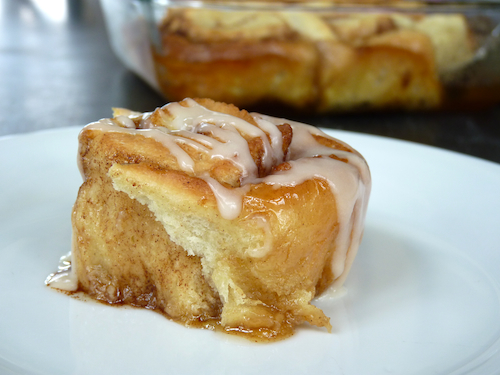






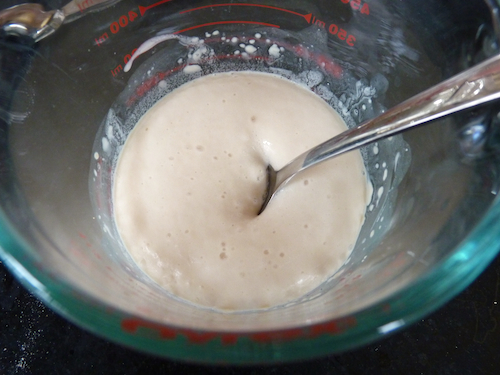
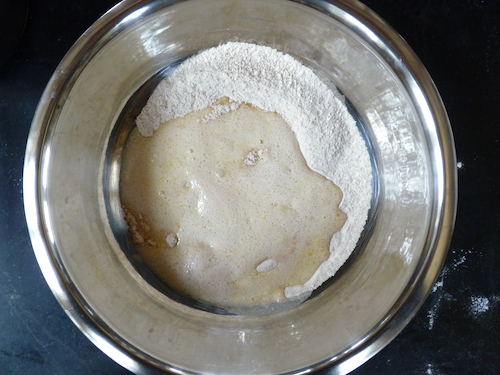
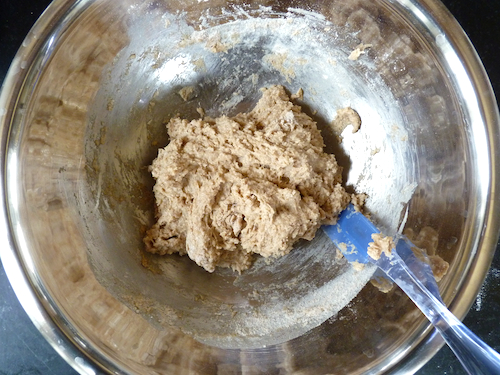

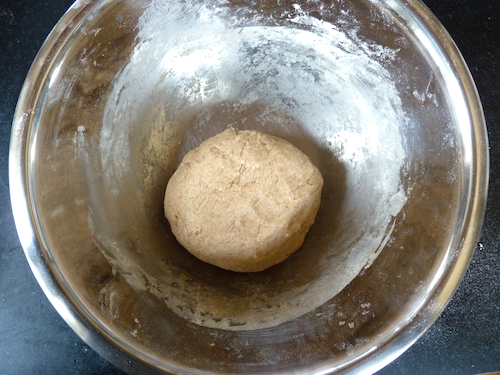
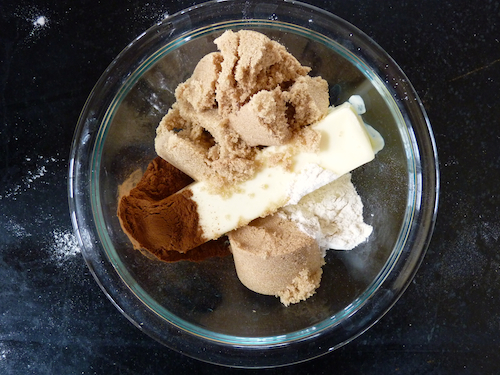
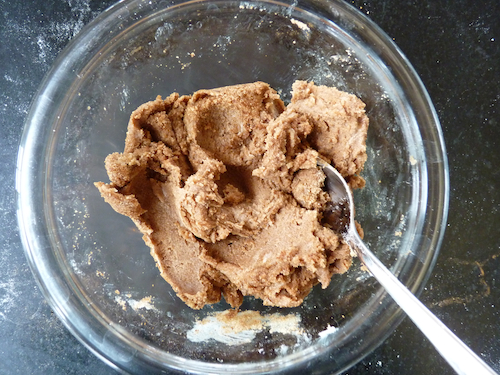
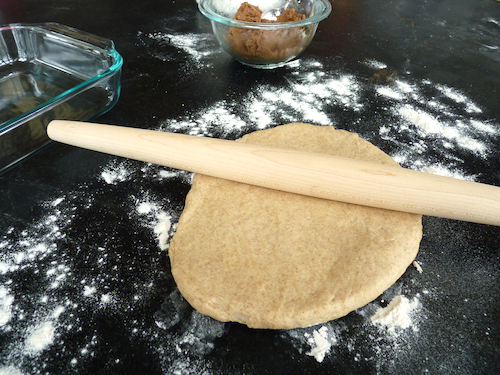
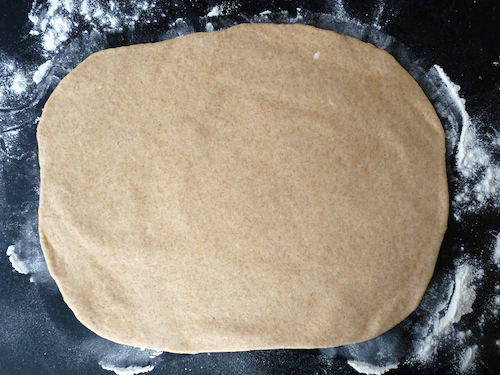
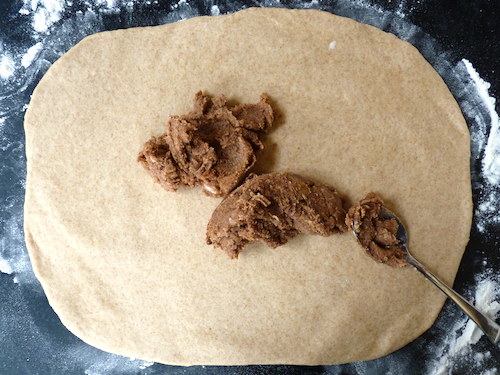
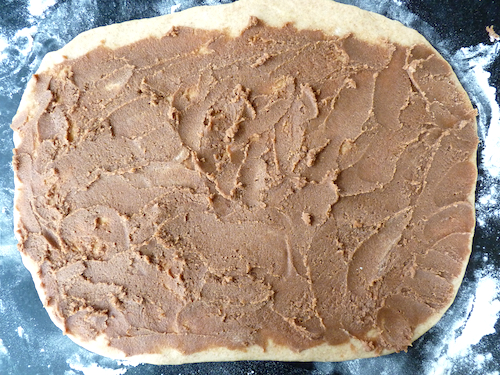
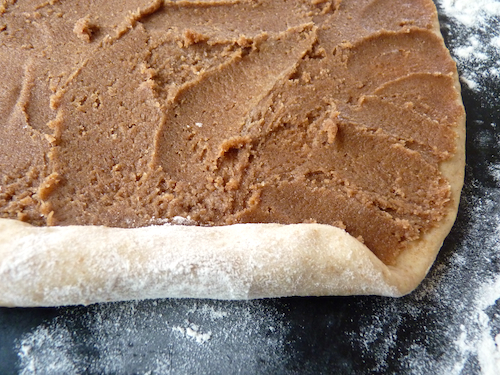
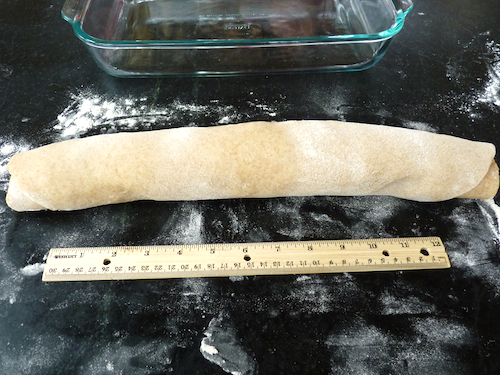


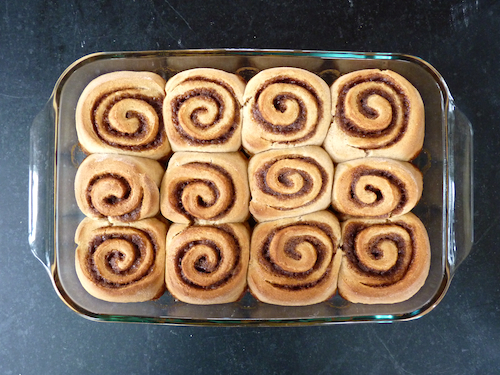
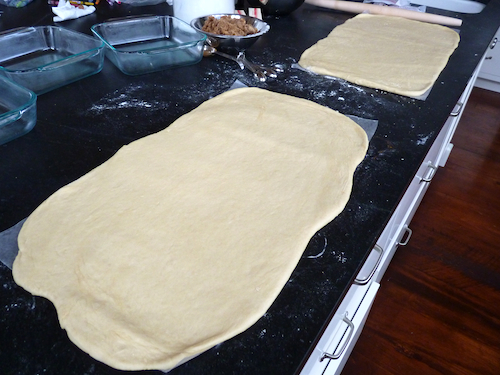
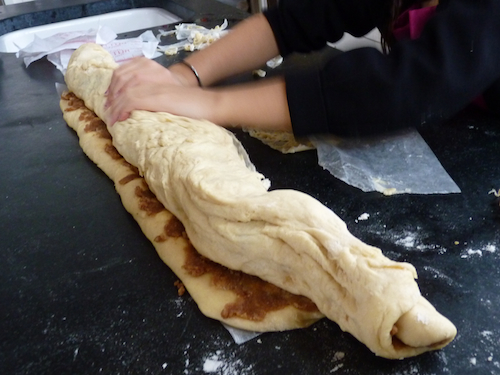
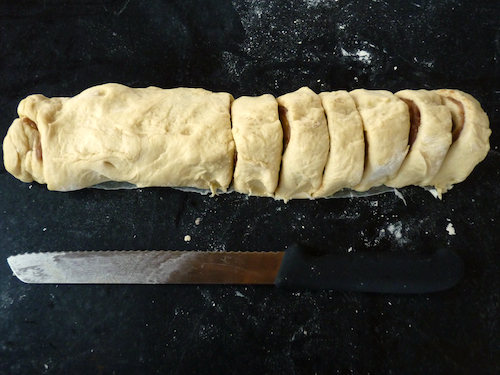
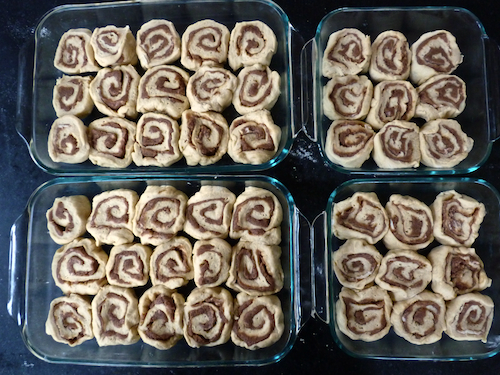
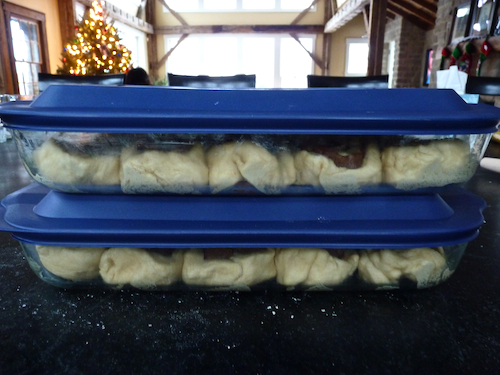

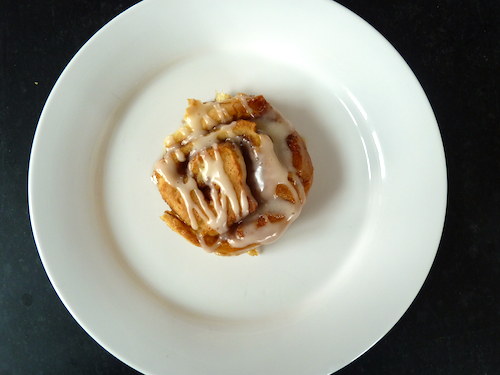


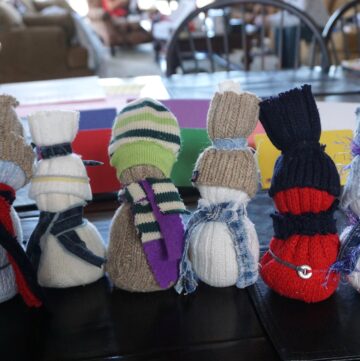

Thanks for the recipe cg!! Sister made this the other day and it was a big hit! =D
wonderful! thanks for letting me know. =)
I am having issues with getting the middle of the cinnamon bun cooked all the way through. What would you recommend? Lower temperature, longer cook time?
hi jessica – so the rolls are still sticky/doughy inside? if the rolls were a pale color before, i would cook another 5 minutes next time. if the rolls were brown on the outside and still not cooked inside, your oven might run hotter than the stated temperature. in that case i would try 325 degrees next time. good luck, and let me know how it turns out.
I used the allrecipes.com recipe for 90 minute cinnamon rolls for about 4 years now. I started looking to make these ahead of time and perhaps find a refrigerated sweet roll recipe. I found yours! It was great. I used the recipe to make cinnamon rolls for a fund raiser. There were raves from everyone and a lady bought a whole dozen tray to take home! Thanks for this time-saving recipe! God’s blessings.
wonderful to hear! thanks for letting me know. =)
Great recipe! I love Allrecipes but it tends to be a gamble if you are trying something for the first time. Since you tried it and it worked well, it was less of a gamble and totally worth it. Thanks for sharing!
hi rachele – i’m glad it worked out for you – thanks for letting me know! thinking about cinnamon rolls is making me hungry…may have to make another batch myself soon.
Hi,
Can u tell me a substitute for egg
Maria
hi maria – the egg isn’t essential, it’s just there for extra richness. you should be able to add an extra tablespoon or two of butter or oil to compensate for the egg. let me know how it turns out. good luck!
Hi cg,
thank you for the response..will let you know once i have done….
hi cg,
i added extra butter and it came out good yummy….
great! thanks for reporting back, very happy the egg-free version worked out for you!
They are in the fridge now! Happy New Year
hi lindsey, hope you liked them! happy 2021!!